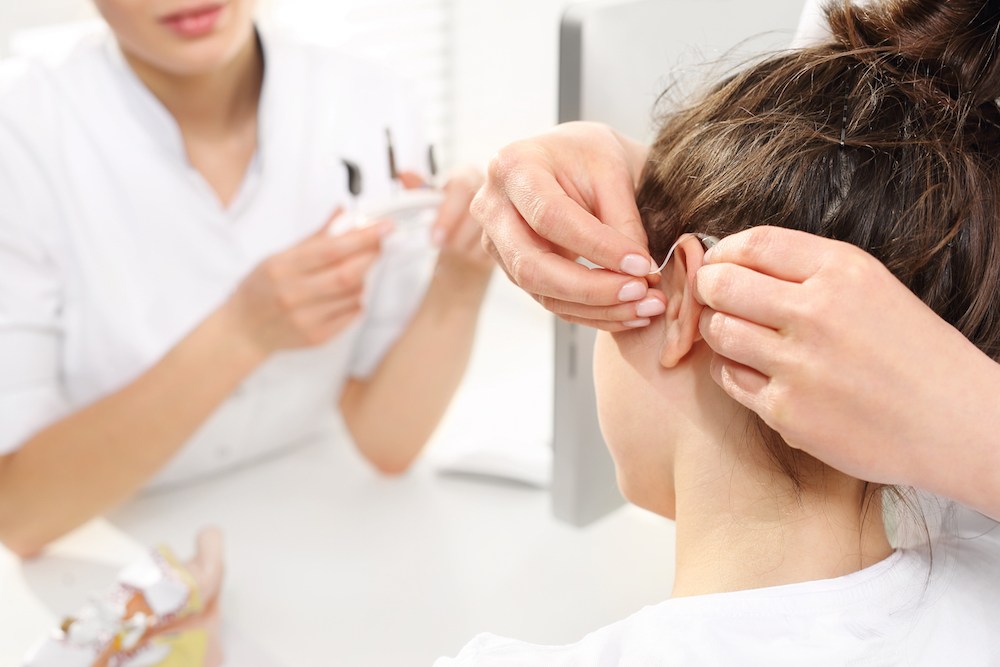How to Choose Hearing Aids for an Active Lifestyle
If you enjoy hiking, playing tennis, working in your garden or

By: admin | January 31, 2024
Understanding hearing loss can be a challenge. It often occurs very gradually, making it difficult for you to assess whether or not you need a test. If you’ve noticed some changes in your or a loved one’s hearing, you’ll want to schedule an appointment with an audiologist for professional testing. Yet, knowing what to expect from hearing assessments can give you a sense of readiness and assurance. These evaluations, carried out by an audiologist, are a fundamental first step in finding the best solution for your specific needs.
Recognizing the early signs of hearing loss is crucial for timely intervention and improved quality of life. One common indicator is experiencing constant ringing in the ear, known as tinnitus, which can signal a potential hearing issue. Difficulty hearing everyday household sounds, like the phone or oven timer, may also suggest hearing impairment. As hearing loss progresses, challenges in discerning important information amidst background noise may arise, emphasizing the need for effective hearing aids equipped to handle such environments.
Another warning sign is the preference for technology or media over personal conversations, indicating potential hearing difficulties. Dependence on lip reading or visual cues for communication can further highlight the presence of hearing loss, especially if understanding conversations becomes challenging without these aids. A simple test, like trying to follow a conversation with your back turned, can provide insights into potential hearing concerns.
Hearing assessments are a crucial part of your hearing health journey. These evaluations aim to identify the precise nature of your hearing loss. The process starts with a thorough review of your medical history and an examination of your ears. A series of tests follow that evaluate how well you can hear different sounds and frequencies. The results lay the groundwork for any future treatment plans.
A variety of tests may be used during your assessment. These could include one or more of the following: pure tone testing, speech testing, middle ear analysis, and otoacoustic emissions (OAEs) testing. Each test offers valuable insights into different aspects of your hearing.
To make the most of your hearing assessment, it’s suggested that you come well-rested and ready to fully participate in each test. Keep in mind, there’s no right or wrong answer – just be as truthful as possible about what you can hear during each test.
If you’re going through a hearing assessment for the first time, it’s normal to feel a little nervous. However, knowing what to expect can help alleviate some of those nerves. Being aware of the process not only readies you mentally but also helps you maximize your visit. This understanding allows you to actively participate in your hearing health care, leading to better outcomes.
The journey towards better hearing health begins with an initial consultation. During this meeting, your hearing health professional will ask about your personal and family history related to hearing health. They’ll want to know about any instances of prolonged exposure to loud noises or medications you’ve taken that could affect your hearing.
Next, they’ll ask about symptoms you’re experiencing. This can include difficulty understanding speech in noisy environments or a constant ringing in your ears. Your responses will provide valuable insights into potential causes of your hearing loss and guide the specialist in choosing appropriate tests.
The initial consultation is all about gathering information. It’s an opportunity for the specialist to learn more about you and for you to voice any concerns or questions you may have.
A physical examination plays a significant role in your hearing assessment. It’s during this part of the process that the hearing health professional can visually check for any signs of abnormalities or blockages in your ear canal that could be contributing to your hearing loss. In this examination, you can expect the audiologist to look for three main things: wax build-up, signs of infections and structural issues. Understanding these elements is important as they directly influence the results of your hearing assessment and subsequent treatment plans.
Audiometric testing is a series of tests that measure how well you can hear different sounds, tones, and frequencies. It’s not just about whether you can hear these sounds, but also about how clearly and accurately you perceive them. At the end of this testing phase, your hearing health professional will have a detailed understanding of your hearing capabilities. This information plays a crucial role in determining the best course of action for managing your hearing loss.
Pure-tone audiometry is a fundamental hearing test that assesses an individual’s hearing sensitivity across a range of frequencies. Conducted in a soundproof environment, the test involves presenting tones of varying pitch and intensity through headphones to the listener. The individual indicates when they can perceive the sound by pressing a button or raising their hand. The results are plotted on an audiogram, a graph that depicts the threshold levels for each frequency. This comprehensive evaluation helps audiologists identify the type and degree of hearing loss, enabling tailored interventions such as hearing aid fittings or other necessary measures to address specific hearing needs. Pure-tone audiometry is a crucial diagnostic tool that provides valuable insights into an individual’s auditory function and guides appropriate management strategies.
During speech audiometry, individuals can expect a series of tests designed to evaluate their ability to hear and understand spoken words. This assessment involves the presentation of recorded or live speech stimuli at varying volumes and pitches. Patients may wear headphones or listen to the speech through speakers while repeating or responding to the words they hear. The audiologist measures the individual’s ability to hear and discern different speech sounds, aiding in the identification of potential hearing issues. Speech audiometry is valuable in assessing not only the detection of sounds but also the clarity of speech, providing crucial information for the diagnosis and management of hearing disorders.
Tympanometry and otoacoustic emissions are two more diagnostic tools. Tympanometry measures the movement of your eardrum in response to changes in air pressure. It helps identify issues in the middle ear, such as fluid build-up or perforated eardrums, which can impact your hearing abilities. OAE testing involves playing sounds into your ear and measuring the “echo” that comes back. This test provides insights into how well your inner ear, or cochlea, is working. These advanced tests offer more detailed information about your hearing health and can guide specialists towards a more tailored treatment plan for you.
Before deciding on a treatment plan, it’s important to consider your lifestyle and specific hearing needs. Your hearing health professional will discuss with you your daily activities, your work environment, and any hobbies you may have that require good hearing. This information will help the specialist recommend a treatment plan that fits seamlessly into your life.
For instance, if you work in a noisy environment or enjoy attending concerts, you may benefit from hearing aids with noise reduction features. If you enjoy swimming or other water activities, waterproof hearing aids may be the best option for you. Understanding your lifestyle and hearing needs ensures that the treatment plan not only addresses your hearing loss but also enhances your overall quality of life.
Hearing loss doesn’t just affect you; it also impacts those around you – your family and friends. Involving them in your hearing journey can be beneficial. They can provide additional insights during your assessment, help you remember important information, and offer emotional support.
Having a family member or friend accompany you to your hearing assessment can also help them understand what you’re going through. This understanding can lead to more effective communication and a stronger support system at home.
You might be wondering, “What do all these numbers and charts mean for me?” Many people find it difficult to understand their hearing test results at first. But did you know that nearly 48 million Americans have some degree of hearing loss? Yet, every person’s experience with hearing loss is unique. This is why understanding your individual test results is so important. Your hearing health professional will interpret these results and explain them to you in a clear and easy-to-understand manner.
Hearing test results are often presented through an audiogram, which visually represents a person’s hearing thresholds across various frequencies or pitches measured in Hertz (Hz). The audiogram typically charts frequencies from low to high along the horizontal axis and depicts the intensity or loudness of sounds in decibels (dB) along the vertical axis. Different parts of the audiogram correspond to specific frequency ranges, like low frequencies (125-250 Hz), mid frequencies (500-2000 Hz) and high frequencies (4000-8000 Hz). Understanding these frequencies is crucial, as low frequencies contribute to perceiving bass sounds, mid frequencies are essential for speech comprehension, and high frequencies are crucial for discerning consonants. The hearing test assesses an individual’s ability to detect these frequencies at varying loudness levels, providing a detailed profile of their hearing sensitivity across the audible spectrum.
After a comprehensive hearing assessment, the next step is to consider the various treatment options available. Your hearing health professional will guide you through this process, presenting options that best suit your specific type and degree of hearing loss.
Hearing aids are often a recommended solution, with different styles and technologies to fit individual needs and lifestyles. They come in a variety of styles, ranging from the most discreet, invisible-in-canal (IIC) options, to large, easier-to-handle behind-the-ear (BTE) products. Your audiologist will talk to you about which options are viable for your specific needs and will help you determine the best solution.
With a clear understanding of how – and why – hearing assessments are conducted; you’re now better equipped to take that first step towards improved hearing health. You’ve learned about the importance of these assessments, the different tests involved and how they contribute to identifying a personalized treatment plan for your unique needs.
At Baker Audiology & Hearing Aids in Sioux Falls, SD, we’re committed to guiding you through this process. Our dedicated team of hearing health professionals is here to answer any questions and provide professional support tailored specifically for you. Seeking help early can lead to more effective management of your hearing loss.
Ready for your next step? Feel free to reach out and schedule an appointment at our Sioux Falls location by calling (605) 610-3466. We look forward to helping you hear life’s moments clearly again.
Tags: audiology services

If you enjoy hiking, playing tennis, working in your garden or
By: admin | June 20, 2025

Hearing loss can make understanding speech difficult. You may notice that
By: admin | February 18, 2025

In the world of hearing care, it’s important to trust the right
By: admin | October 30, 2024
